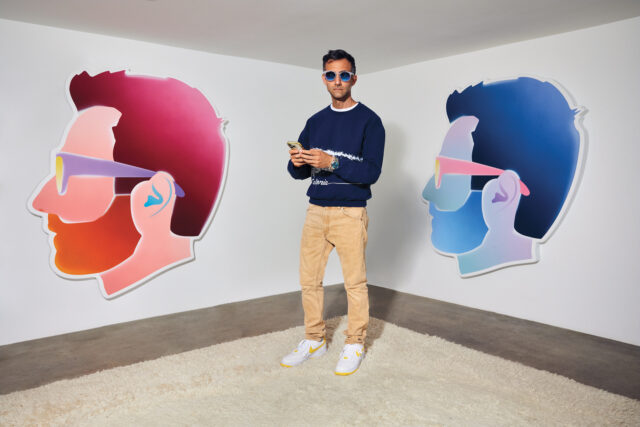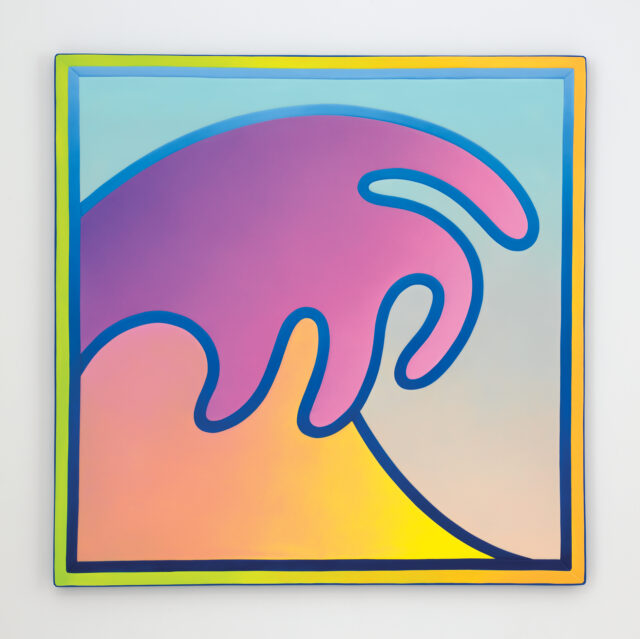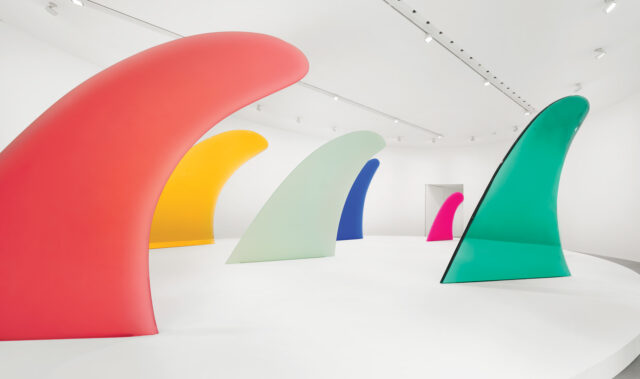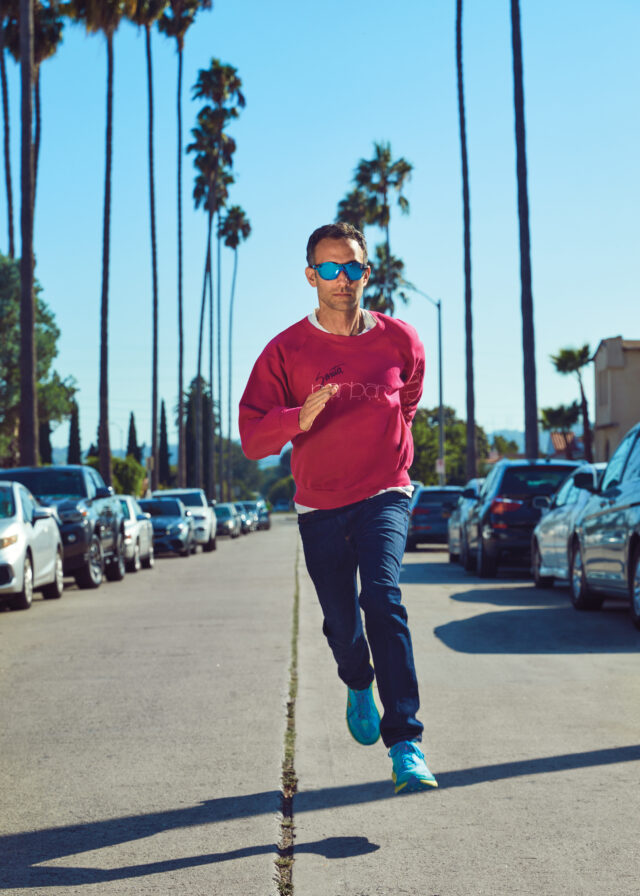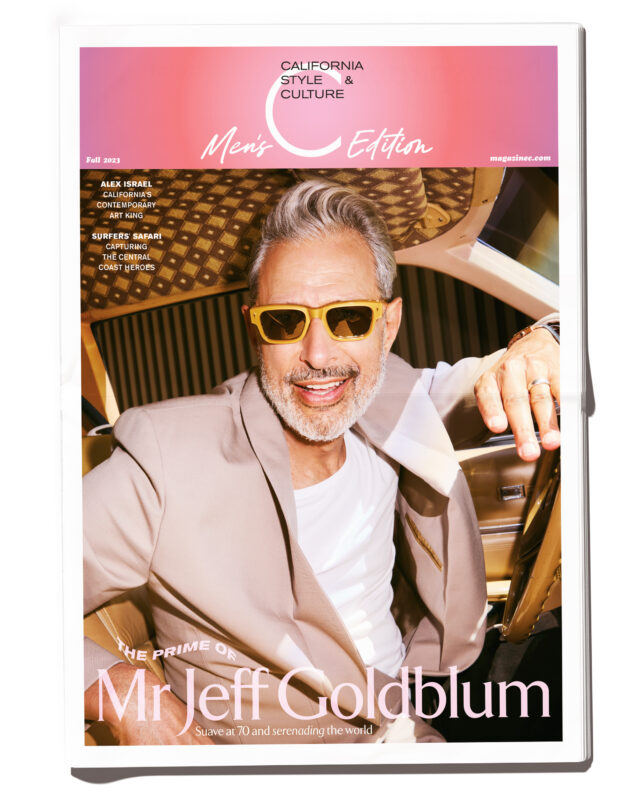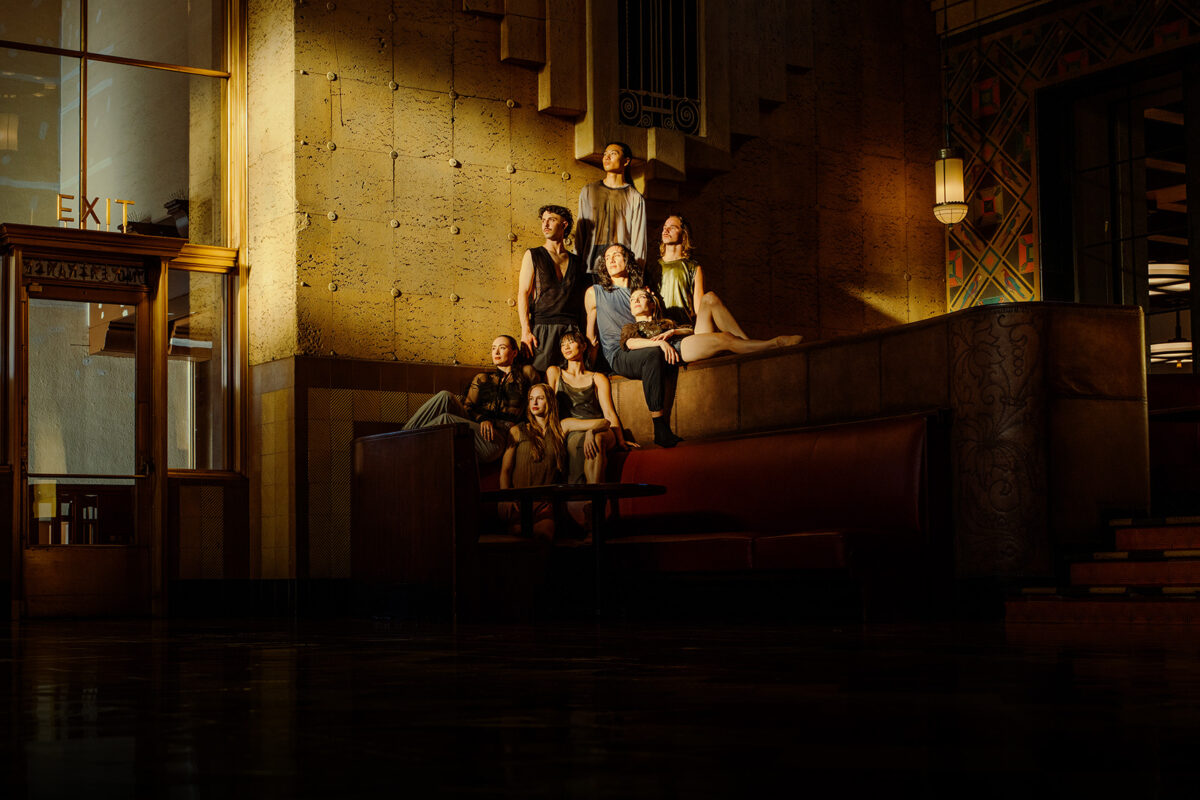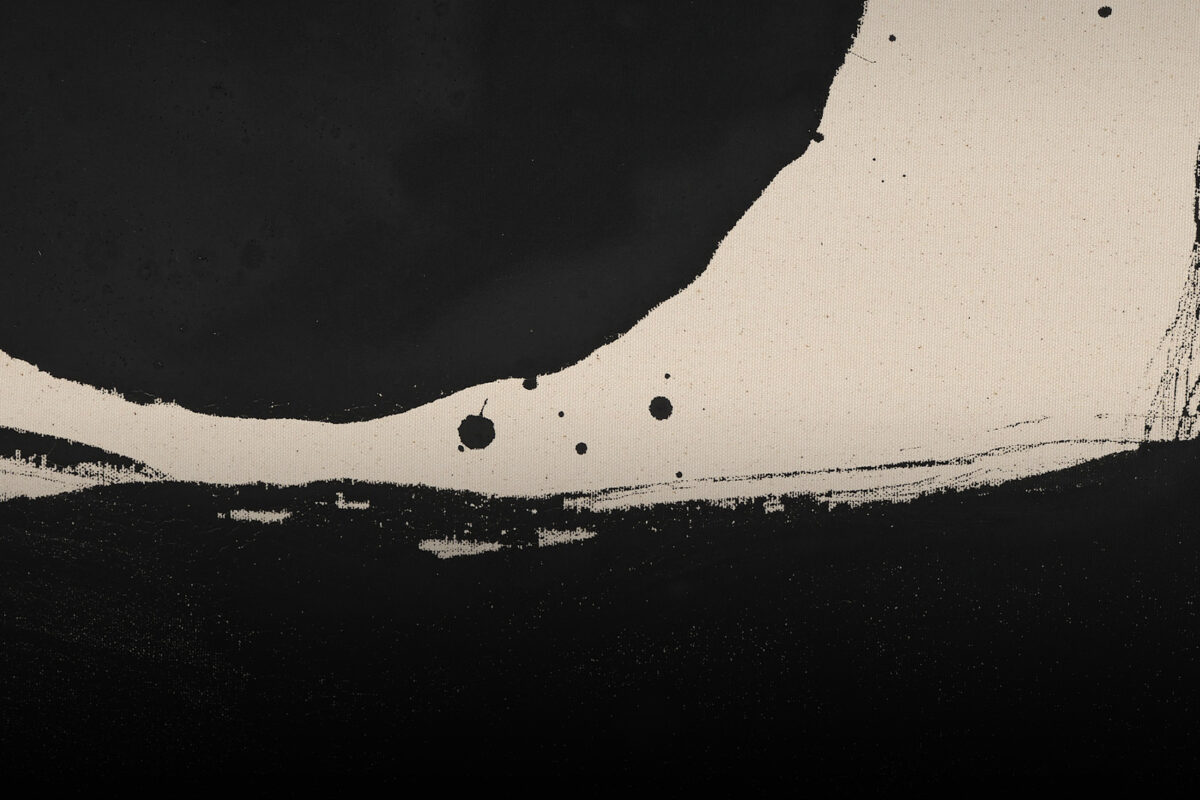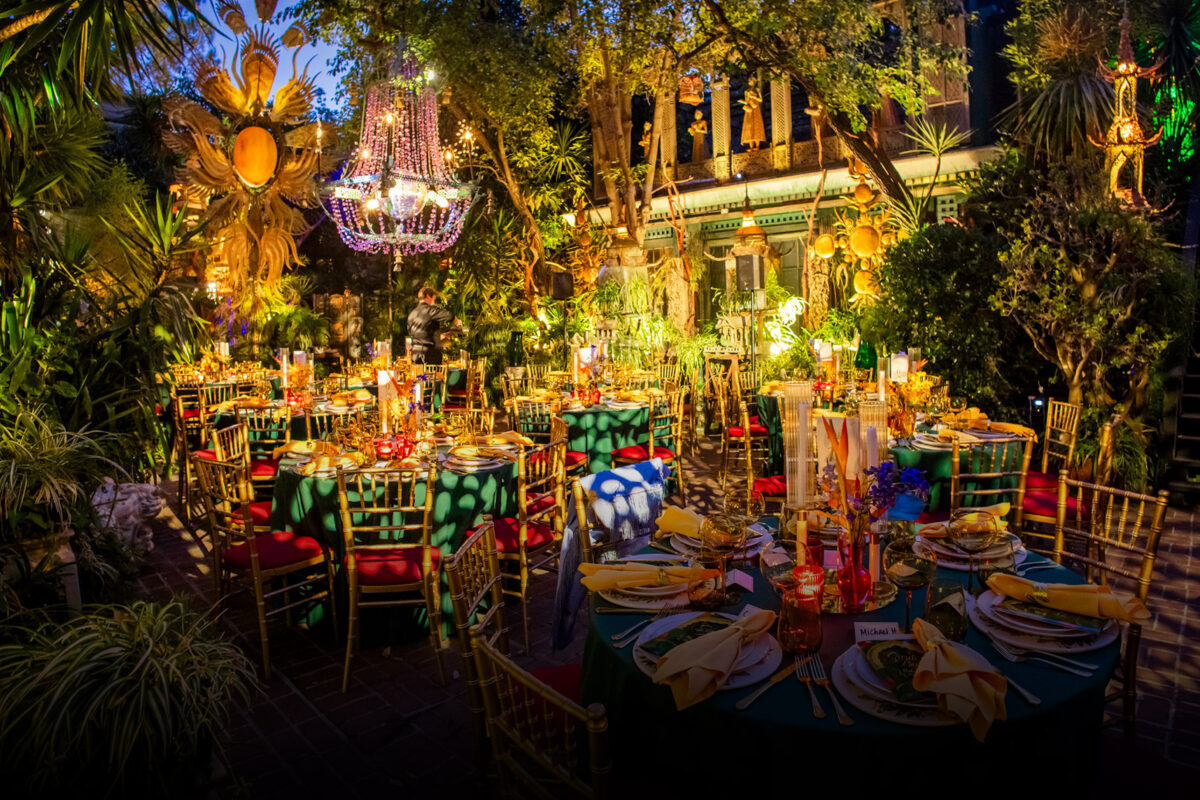By turning Golden State icons into highly collectible works, the artist has soared to the highest echelons of the contemporary art world. So what’s next?
Photography by DANIELLE LEVITT
Words by KELSEY MCKINNON
Artist Alex Israel, in signature sunglasses, photographed in his Mid City studio.
Over the past few months, artist Alex Israel’s giant plastic Fins sculptures emerged from the floor of Gagosian Gallery in Rome like a pod of technicolor dolphins breaching off the California coast. L.A.’s native son has made a career out of interpreting and reinterpreting California’s pop-laden iconography into works of fine art, from sculptures of frozen yogurt, sunglass lenses, wetsuits, and Oscar statue boxes to his recent Wave paintings. One of his earliest pieces was the deadpan celebrity interview show As It Lays, out of which his now-iconic Self-Portrait series was born (Israel’s profile originally served as the show’s logo).
As much as Israel’s work acts as a commentary on the cultural zeitgeist, he has also become enmeshed in it himself. For example, in a recent episode of And Just Like That, Charlotte sells one of his self-portraits to singer Sam Smith. All of Israel’s paintings — from the sherbet-hued Flats depicting California sunsets to the ethereal Sky Backdrop series and the fiberglass profiles — are made in Warner Bros. Studio’s old scenic painting department in Burbank. Over the hill, Israel’s gallery-like Mid City headquarters is where he stages exhibitions and manages a constant stream of ideas.
At 41 years old, Israel has positioned himself at the front of the lineup, so to speak, and as an obvious successor to the artists who helped turn L.A. into a cultural capital, including John Baldessari, Jason Rhoades, and Lita Albuquerque (all of whom Israel has worked for). Filtered through Israel’s sun-drenched Millennial experience — he grew up on L.A.’s Westside, his father is a real estate developer and his mother is a former schoolteacher, he attended Harvard-Westlake School before graduating from Yale and earning an M.F.A. from USC — his work reaches across art, film, fashion, and tech. Take his collaborations with L.A. cultural chieftains like Baywatch creator Michael Berk for a Netflix teen movie called SPF-18 or author Bret Easton Ellis on a series of text paintings or Evan Spiegel of Snapchat, in addition to commissions for global luxury brands including Rimowa and Louis Vuitton. Although Israel has been known to use AI to generate press releases and statements, we sat down with him to hear, in his own words, about his endless source of inspiration, his tendency to double-book nightly dinners, and what’s next on his airbrushed California horizon.
Israel poses with two self-portraits.
Congratulations on the success of Fins, which was shown in Rome. What do you think people from around the world love so much about California?
Thank you. Making the show was a multiyear labor of love, and I’m so happy with how it all came together. I think California symbolizes freedom. It’s a place where people come to reimagine their lives and to become whomever they want to be. And the allure of that freedom is magnetic. People from all around the world are drawn to this idea, this sense of possibility that is the California dream.
How did you create the fins?
I still work with the fabricators at Warner Bros. to make the majority of my work. The fins, however, were made in an area of Rome called Pomezia. I worked with a team of plastic experts to perfect the colors, shapes, and engineering.
What specifically were you trying to say with these pieces?
The surfboard fin is a simple object that helps get you where you want to go. The wave, the sun, the board, the sunset, the sea life, the pelicans, the wetsuits, the SPF, the tan, the sunglasses, the sky, the custom cars, the palm trees, the fins — these are just some of a long list of details that make up this epic picture or idea of Californian freedom. I’m just zooming in on a detail and using it as a symbol to evoke this sense of freedom and possibility, but also as a means toward creating what is hopefully a joyous, humorous, immersive sculptural experience of color, light, and space.
So much of your work explores the iconography of California. How and when do you find inspiration?
I find inspiration mostly when I’m in transit, like on my morning walk for coffee or a protein smoothie, driving to work with the windows rolled down and a favorite new pop song on repeat, hearing the notification that the Fasten Seat Belt sign is now on and the descent toward LAX is imminent. In situations like these I’m really able to relax and think creatively. I’m endlessly fascinated and never not inspired by L.A.
California is a place where people come to reimagine their lives and to become whomever they want to be
alex israel
Wave, 2018, acrylic on fiberglass, 72 x 72 inches. Photo by Martin Wong. Courtesy the artist and Gagosian.
Are you planning to build on the Fins series or are you working on something else now? How do you decide what to do next?
Both. I’m working on a second iteration of Fins for a show next year in London. I’m also working on other projects, both for traditional art exhibitions and other contexts. Whatever I’m working on or making generally leads me to the next thing I make. I guess it’s like a chain reaction. I’m usually working on multiple projects, so there are multiple chains. I tend to think of my work not in terms of individual pieces or projects, but rather as one life’s work, a single project. A novel can be broken down into chapters and paragraphs, but ultimately every sentence, every word exists together in service of a single, overarching narrative.
So much of your work explores ideas within celebrity culture. Now that you’ve become a celebrity in your own right, does it feel like the tables have turned? Do people recognize you on the street?
I’m rarely recognized on the street, although it does happen every once in a while. Justin Bieber is a celebrity. Zendaya is a celebrity. I’m just an artist trying to get my work done and thinking a lot about how it might reach an audience outside the art world. So many people don’t live near museums or galleries, and I want them to experience my work as it’s meant to be seen, meaning I want people to get the actual work, not just its documentation. So that’s why, in addition to making art for gallery and museum exhibitions, I’ve always made things for the online context — YouTube, Snapchat, and Netflix — and why I’ve also always made products that circulate outside the art market. The best thing about achieving a certain amount of recognition, especially outside the art world, is that it opens up possibilities for more projects to unfold in new realms.
Fins, 2023, installation view, Gagosian, Rome. Photo by Matteo D’Eletto. Courtesy the artist and Gagosian.
Your work has such a sense of optimism. Is it easy to be optimistic about pop culture and the culture of L.A. in particular?
I love trying new things. I love learning. I love invention and reinvention and the power that creativity wields in our world. I’m a naturally optimistic person, so being optimistic is pretty easy for me.
When did you acquire this new studio space, and can you share how you’ve designed it?
I moved into the space five years ago and renovated it for about a year before that. I worked with my brilliant architect friends Sharon Johnston and Mark Lee to make the old, abandoned building work for me. The big double-height space acts like a soundstage, and it’s where I shot the second season of my web series As It Lays. The front space acts like a mock gallery, so I can stage and imagine what the things I’m making might look like when exhibited for public viewing. There is enough shelf space for all my books, a little room where I can escape for a nap, and even a small built-in doghouse for my late cockapoo, Mr. Brown. It’s a space where I can work, read, think, and entertain.
Do you have a very regimented work schedule? What does a regular day entail? What do you do to unplug?
I like to imagine that I work every day from 10 to 6, but the truth is that work starts the minute I get up at 7:30 and usually goes well into the night — more often than not, dinners and evening events focus on work. I don’t like making plans for lunch because it really breaks up the day, so I’ll meet people for morning coffee/breakfast or for dinner. It’s common for me to plan two dinners a night — an early and a later seating, so to speak — so I can see more people and get more done. I’m out for dinner just about every night. And I walk and/or work out every morning to keep myself sane. This year I’m averaging 15,000 steps per day.
It’s common for me to plan two dinners per night so I can see more people and get more done
alex israel
“This year I’m averaging 15,000 steps a day.”
How much traveling do you do on the global art circuit?
A lot! I’m probably gone between one and two weeks per month.
How and when did you initially meet Larry Gagosian? How would you describe your relationship?
A former Gagosian gallery director named Sam Orlofsky became interested in my work when I was a graduate student, followed my career thereafter, and ultimately introduced me to Larry. Larry and I have a very nice relationship. He’s engaged in what I’m doing, we discuss potential future projects, and he’ll often invite me over for dinner at home when he’s entertaining guests here in L.A.
Not to ask you an As It Lays kind of question, but what do you consider to be your big break as an artist?
In fourth grade I won the contest to design our class T-shirt, which everyone wore on a field trip to Sacramento.
Has your career been a case of a grand plan coming together over the past 15 or 20 years or has everything happened by accident?
A little of both.
We loved hearing that the animal you identify with most is the pelican. Why?
Social. Big beak. Loves raw fish and cruising up and down the coast.
Feature image: A work from his Sky Backdrop series.
This story originally appeared in the Fall Men’s Edition 2023 issue of C Magazine.
Discover more CULTURE news.
See the story in our digital edition


